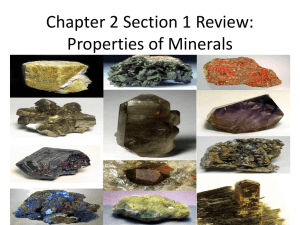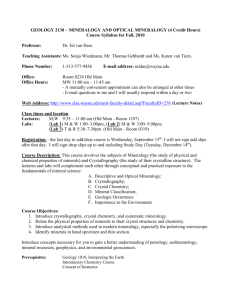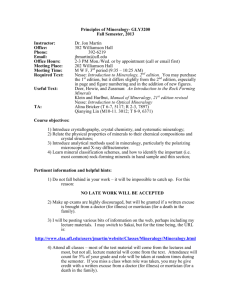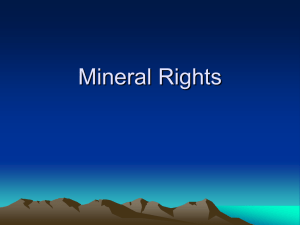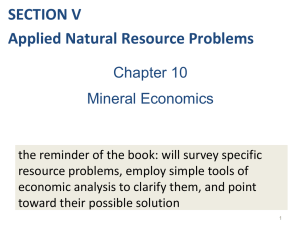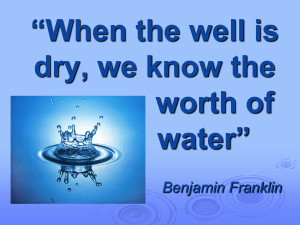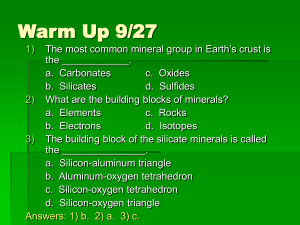Mineralogy Lecture 02
advertisement
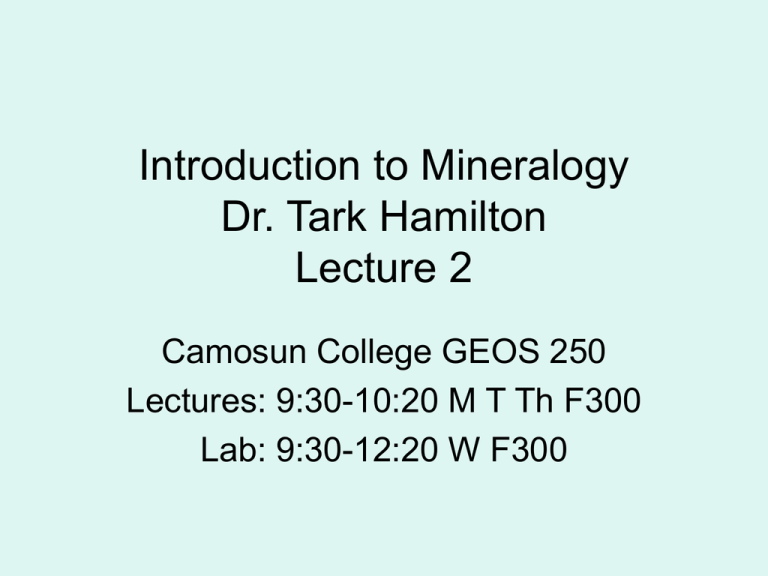
Introduction to Mineralogy Dr. Tark Hamilton Lecture 2 Camosun College GEOS 250 Lectures: 9:30-10:20 M T Th F300 Lab: 9:30-12:20 W F300 A Mineral Cornelius S. Hurlbut • • • • • • • • • • • • • • A mineral is a wondrous thing. At least it is to me, For in its ordered structure lies a world of mystery. The secrets that it has withheld for countless ages past, And clung to most tenaciously and being learned at last. Each year using new techniques or with a new device, We make our knowledge more complete, our data more precise. But let us not in trying to solve a mineral mystery, Forget that minerals are a part of natural history. Nor in our quest for more detail in probing an unknown, Forget that every mineral has a beauty of its own. With progress in technology each year sees new machines, That try to copy nature by sophisticated means. But for all these modern methods we cannot yet compete, With the world of ordered beauty that lies beneath our feet. Course Objectives • Solid Earth Materials (specimens), their structure & chemistry (theory) • Symmetry Elements & Crystallography of regular space filling lattices, Crystal systems, Space groups • Mineral Classification: Dana & Stuntz, Groups by anions, elements, structures. Common silicates & ore minerals • Optical Mineralogy: theory & petrography • Mineral formation, crystallization, kinetics Mineralogy Resources • The Manual of Mineral Science, (Dana’s Mineralogy) 23rd ed., Case Klein & Barb Dutrow, Wiley 2008 • Mineralogy, 2nd ed. Dexter Perkins, Prentice Hall, 2002 • Minerals and Rocks: Exercises in Crystal and Mineral Chemistry, Crystallography, X-ray Powder Diffraction, Mineral and Rock Identification, and Ore Mineralogy Case Klein • Minerals in Thin Section, Dexter Perkins and Kevin Henke, 2nd ed., 2004 • Websites, mineral databases, crystallography, models, symmetry WEB RESOURCES • http://webmineral.com/help/Forms.shtml#isometr ic • • http://www.rockhounds.com/rockshop/xtal/part1. html • • http://www.klingereducational.com/ • • http://home.comcast.net/~eswab/ObjectThumbn ails.html Webmineral.com • • • • • • Mineral name, formula, composition… Crystal form, symmetry, rotational views X-ray diffraction 3 biggest peaks Mineral search by element: Mg, Na, Ti etc. Environment of formation Locality Show a crystal cut-out model: http://webmineral.com/crystal/Isometric -Hextetrahedral.shtml System: Isometric Class: Hextetrahedral (48 faced) Herman-Maugin Symbol: 4bar 3 m Forms: (024), (124) Minerals • • • • • • • Solid Definite composition Naturally occurring Usually crystalline, not all well formed ~ Inorganic (some oxalates (C2O4)-2 ) ~ Form by inorganic processes (some bio) Forming rocks: mono-mineralic or poly- Gas Hydrate Crystal – Type I TETRAKAIDECAHEDRON: Weaire & Phelan, 1993 Methane hydrates are built from water cages held together by hydrogen bonding. Methane molecules held within 14 faced coordination structures. Repulsive, symmetric, energetic methane occupies enough of the sites to hold the structure up and keep it from collapsing under its own weight and water’s intermolecular forces. How Mineral Formation Differs from Synthetic Crystalline Substances • Geological time spans: Quickly (seconds) - Hydrothermal to Slowly – Magmatic crystallization to Mega-annum – Regional Metamorphism • High Temperatures (200°C to 1700°C) & High pressures (102’s–106’s bar) Specific/unusual compositions (Low fO2) • Order/Disorder, inclusions, flaws, cooling Minerals Comprise Rocks • Sedimentary: Grains - Quartz (ancient, Ga), Cements: Dolomite, Greigite (diagenetic, ~a) • Metamorphic: Garnet, Biotite, Quartz, Feldspar (mountain building recrystallized, 107 a) • Igneous: Olivine, Pyroxene, Plagioclase, Magnetite (magma cooling, 100 a - 105 a) • Meteoritic: Kamacite (Fe>Ni), Taenite (Ni>Fe), Troilite (FeS), Olivine ((Mg,Fe)2 SiO4), Carbon (at 4.6 Ga, High-T & Lo-P from Solar nebula) Dol Gr Q Klein & Dutrow 2008, fig_01_09 Mineral Science: What Mineralogists Do • Crystallography: Forms, symmetry, XRD • Crystal Chemistry: Inorganic, substitution, kinetics of formation • Classification: Composition & Structure, ~50 new minerals a year, ~4000 total • Paragenesis: Geological occurrence, assemblage, setting, conditions • Descriptive: Locality, form, habit, colour Klein & Dutrow, 2008 fig_01_08 History of Technical Mineral Use • >40,000 BCE Fe2O3 red & MnO(OH) black cave art & Cu beads • > 3000 BCE Turquoise, Jade hoarded, collection & trade • 2900 BCE Egypt & Bronze Age Greece: Gold smelting & refining • 1500 BCE “Refining minerals” Plaster burners, Charcoal reduction of metal • 1500 BCE Semitic Chetites, Fe tools • 1000 BCE India Fe tools, Egypt Hg • 1300 AD Additional smelting refining Ancient Mineral Writings & Ideas • Heiroglyphics ~2900 BCE (Bronze Age), Au, Ag, Cu-Sn, Ceramics, Enamelwork • Leucippo 500 BCE Theory of “Atoms” • Empedocles 430 BCE Earth, Air, Fire, H2O • Theophrastus 287 BCE “Concerning Stones” • Pliny 79 CE Natural History Cornelius Agricola (1556) De Re Metallica Mining & Ore Smelting Raises, tunnels, ore cars, Winzes, headframes (note clearcut – wood fuel) The Road to Modern Mineralogy • 1669 Nicolaus Steno: Constant interfacial angles of quartz from different places • 1783 Rome d’L’Isle & Carangeot: Goniometer contact & Law of Constancy of Interfacial Angles • 1784 Rene de Hauy: Crystals built up from “integral molecules” (unit cells) • 1801 Rene de Hauy: Rational Indices for Crystal Faces • 1809 Wollaston: Reflection goniometer The Road to Modern Mineralogy • 1874 Miller 2 circle goniometer, dihedral angles • 1889 Federov poles to crystal faces plotted in stereographic projection (Wulff net) shows symmetry between faces • 1914 Von Laue X-ray diffraction of ZnS NP • 1921 G. Tschermak & F. Becke Polarizing Microscope Mineralogy, Alchemy & the Roots of Modern Chemistry • 1660 Robert Boyle: Sceptical Chemist “Elements” used in modern sense • ~1750 Joseph Proust: Elements combine in Definite Proportions Compounds • ~1800 John Dalton, Wm Higgins Law of definite proportions (weight ratios) • 1813 Jons J. Berzelius: Symbols & Atomic weights for 15 elements/Oxygen • 1837 J. D. Dana: A System of Mineralogy • 1870 Dimitri Mendeleyev: Periodic Chart • 1871 J. L Meyer: Atomic volumes vs wts. Lifetime Per Capita Mineral Usage • • • • • • • • 1.64 X 106 Kg all minerals 361 Kg Pb: batteries, solder 261 Kg Zn: brass, cathodics, chemicals 682 Kg Cu: wiring, alloys 1633 Kg Al: aircraft, cans, foil, lawn chairs 14864 Kg Fe: spoons nails cars ships bldg 12824 Kg NaCl: deicing, detergent, food 562773 Kg: Stone, gravel, sand Example Mineral Name Origins • Bytownite (Ab30-10An70-90) Bytown = Ottawa • Calcite (CaCO3) calx, L. Lime • Carletonite (KNa4Ca4Si8O18(CO3)4(OH,F) H2O) Carleton U., Mont St. Hilaire • Cassiterite (SnO2) kassiteros, Gr. Tin • Labradorite (Ab50-30An50-70) Labrador • Monteregianite KCa2AlSi7O17(OH)2·6(H2O) Monteregian Hills PQ, (Hydrodelhayelite) • Sperrylite (PtAs2) F. Sperry (discoverer), ON
